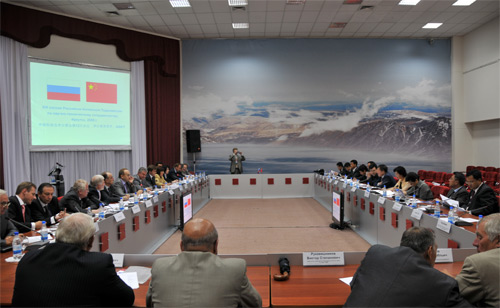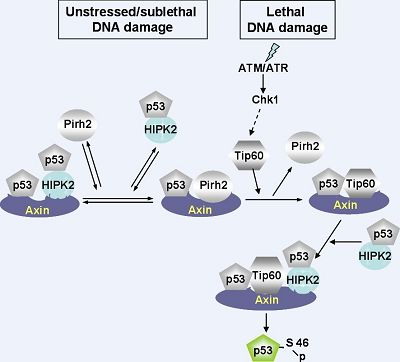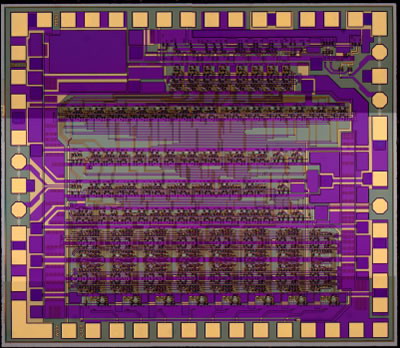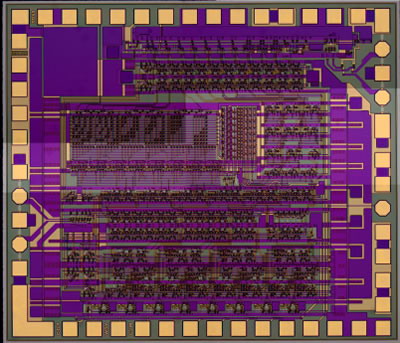|
CHINA SCIENCE AND TECHNOLOGY
NEWSLETTER
The Ministry of Science and Technology
People's Republic of China
|
|
|
N0.557 |
August 30, 2009 |
|
|
|
|
|
|
|
|
IN THIS ISSUE
|
|
*China-Russia S&T Meeting
* Silkworm Genome Sequence Completed
* New Signaling Pathway Found for Colon Cancer
* Successful Stratospheric Radiosonde Launch
*Digital Control for Mega Kilowatt Nuclear Generator
* Key Techniques for Spallation Neutron Source
|
|
INTERNATIONAL COOPERATION |
China-Russia S&T Meeting

The 13th routine S&T Cooperation Sub-Committee meeting, established under the regular meeting mechanism between Chinese and Russian Prime Ministers, was held on August 13, 2009 in Irkutsk, Russia.
At the meeting jointly chaired by CAO Jianlin, Chinese Vice-Minister of Science and Technology, and С.Н.Мазуренко, Director of Science and Innovation under the Ministry of Education and Science of the Russian Federation, both sides shared the latest S&T developments in their own countries and associated international S&T cooperation, reviewed and adopted the working report of China-Russia high tech and innovation working panel, examined the intergovernmental S&T cooperation projects implemented in 2008-2009, and discussed S&T cooperation initiatives for the period of 2009-2011. Both sides exchanged views on deepening S&T cooperation between the two countries, especially in the area of high-tech and innovation, and forged a broad consensus.
Both sides agreed that it is necessary to adopt measures to further deepen the substantive cooperation between the two countries in the area of science/technology and innovation, and jointly implement a number of innovation projects enjoying high investment and market potentials. Both sides agreed to promote multilateral S&T cooperation under the framework of Shanghai Cooperation Organization, and further strengthen effective collaborations between research institutes, scientific and production associations, and enterprises in the border areas shared by both countries.
After the meeting, CAO and Мазуренко inked a protocol reflecting the major accomplishments of the routine meeting. During the meeting, the Chinese delegation attended the opening ceremony of Irkutsk Branch of Moscow based China-Russia Friendship S&T Park, and visited industrial groups, university S&T parks, and universities in Irkutsk.
First KRIOS Microscope in Asia
A KRIOS cryo-transmission electron microscope, the first of its kind in Asia, was installed on August 25, 2009 at Tsinghua University, thanks to the collaboration between the Medical School of the University and FEI. Both parties signed a cooperation accord at the ceremony. According to the accord, FEI will allow Tsinghua University Medical School to use a USD 1.4 million worth Tecnai TF20 cryo-transmission electron microscope free of charge for one year, mainly for studying the three-dimensional structures and functions of major biomacromolecules. Meanwhile, FEI will secure a full support to Tsinghua University in the area of research, applications, training, and software/hardware maintenance and upgrade.
Silkworm Genome Sequence Completed
Not long ago, researchers at Beijing Genomics Institute (Shenzhen) and their collaborators at Southwest University published a new finding on silkworm genome sequence in the journal Science. As a follow-up to the findings on domestic silkworm genome sequence achieved in 2003, Chinese scientists have completed the sequencing of 63.25 billion base pairs in 40 mutated domestic silkworm species and selected wild Chinese silkworm species, covered 99.8% of the genomes possessed by silkworm. The efforts has led to the birth of the world’s first silkworm genetic mutation chart at the genome level, and to the discovery of genome signatures imbedded in domesticated silkworm, allowing people to understand the origins of domesticated silkworm at the full genome level.
Comparing with wild silkworm, domesticated silkworm enjoys better economic properties. The selective genome signatures discovered in the study are important for people to understand the mutated selective genes that can be cloned for enhancing the economic performance of domesticated silkworm.
New Signaling Pathway Found for Colon Cancer
TONG Dandan, a young lecturer at Harbin Medical University, and coworkers found through a study that RUNX3, a cancer inhibitory gene, inhibits the growth of colon cancer cells and induces cancerous cells apoptosis through both TGF--dependent and -independent pathways. The finding provides new knowledge and orientation for understanding the pathogenesis of colon cancer and associated clinical treatment.
TONG and collaborators found in a pre-study that TGF-β dependent pathway is able to inhibit the growth of cancerous cells. To sort out more facts about cancerous cell inbihibition, they made an attempt to see if other pathways may also play the same trick. Researchers started from colon cancer, stimulating colon cancer cells using TGF-β, and observing the growth and multiplication of cancerous cells, and protein expression in the pathways. They eventually found that cancer inhibitory gene RUNX3 works well through both TGF--dependent and -independent pathways.
Internal Mechanism of Cancer Prevention

A study, led by LIN Shengcai at Xiamen University School of Life Sciences, has unveiled the internal mechanism of cancer prevention at the cellular level, a new breakthrough applauded by the cancer research community. LIN and coworkers found that a cell called Axin is able to determine the cell fate by controlling the p53 activation threshold after DNA damage. Researchers also found that Axin is a critical determinant in p53-dependent tumor suppression in which Pirh2 and Tip60 have different roles in triggering cell-cycle arrest or apoptosis depending on the severity of genotoxic stress. The finding, published in August 23, 2009 issue of journal
Nature Cell Biology, provides new thinking and approaches for cancer treatment.
Successful Stratospheric Radiosonde Launch

LAGEO, a global environment lab under the Chinese Academy of Sciences, made a successful drop of balloon radiosonde from the stratosphere on August 5, 2009 at the Xilinguole pasturelands in Inner Mongolia. A 45-kg nacelle carried by a huge balloon (1000m3 for its volume) was launched at 0646, and reached the height of 25km at 0835. It dropped the first GPS radiosonde at 0936, which descended at a normal speed, and collected the needed data. Nacelle dropped a novel radiosonde at 1045, which collected and transmitted data as designed. The nacelle was cut off at 1208, and landed on the ground at 1300. It was soon positioned and recovered.
It takes more than 2 years for researchers to complete the design, development, lab test, and field launch of the balloon radiosondes suitable for dropping from the stratosphere. Researchers have mastered a range of needed key technologies, including GPS radiosonde, drop control unit/program, satellite data communication upgrade, and power supply. The new balloon radiosonde is able to make a number of drop attempts under remote control, measuring temperature, air pressure, humidity, wind speed, and wind profile between the stratosphere and ground. When drifting horizontally, it can also collect temperature, air pressure, wind speed, and wind direction data on a continuous basis at a given height. It provides a new technical means for monitoring weathers and studying the dynamic processes of lower stratosphere in uninhabitable areas, such as oceans and deserts.
10GHz 8-bit DDS Chips

DDS1 chip

Output wave of DDS1 at 128h(5GHz sine wave)

DDS2 chip

Output wave of DDS2 at 8h(156MHz sine wave)
A research team, led by LIU Xinyu and Jin Zhi at Institute of Microelectronics, part of the Chinese Academy of Sciences, have rolled out 1um GaAs HBT based DDS1 and DDS2 (Direct Digital frequency-Synthesizer) chips. Tests show that DDS1 is able to work properly at an internal clock frequency larger than 10GHz, with 26dBc for DC-5GHz output. DDS2 works properly within 5GHz, with 45dBc for DC-2.5GHz output. The enhanced DDS chips have greatly raised the maximum frequency of DDS circuits in the country, but also demonstrated the highest GaAs HBT based DDS clock frequency level in the world.
Digital Control for Mega Kilowatt Nuclear Generator
China Guangdong Nuclear Power announced on August 28, 2009 that a KIT/KPS upgrade project designed to digitize data collection and processing at China’s first mega kilowatt nuclear power station passed the verification check at the Dayawan Nuclear Power Station. The development marks that China has mastered the key technologies to build a highly advanced digital control system for mega kilowatt nuclear generators. The upgraded KIT/KPS system enjoys a range of newly added advanced functions, in addition to its originally designed ones. With an enhanced performance, the new system works better in reliability, real-time collection, data volume, openness, scalability, and applicability, compared with the former system.
According to a briefing, the KIT/KPS system has had its control module been upgraded from analog to digital, the largest digital upgrade ever seen in China’s nuclear power industry. It paves way for future efforts to build home made digital control system for mega kilowatt nuclear generators.
Solar Power Grid
A 10-megawatt grid photovoltaic system, the largest of its kind in the world, broke the ground on August 28, 2009 in Dunhuang, Gansu. Physically located in the southwest of Qili Township, the Dunhuang Municipality, the project occupies an area of 1 million square meters, and will consume an investment worth RMB 203 million. Designed with an annual capacity of 18.05 million kilowatt hours of electricity and a tariff at RMB 1.09 per kilowatt hours of electricity, the grid photovoltaic system will be completed of construction in 14 months, and put into operation at the end of 2010.
To take full advantage of the solar power infrastructures built by the Dunhuang Municipality, China Guangdong Nuclear Power has filed an application for building a 50-megawatt grid photovoltaic system in the same city before the National Energy Administration, while preparing to build a 2,000 megawatt grid photovoltaic system, in collaboration with equipment makers and local businesses, in an attempt to create a model for developing large scale photovoltaic grid systems in the country.
Key Techniques for Spallation Neutron Source
On August 21, 2009, the steering panel of China spallation neutron source opened its first meeting in Guangzhou.
Thanks to 3-odd year pre-study, Chinese scientists have mastered major techniques to build a spallation neutron source, and submitted in July 2009 a feasibility report to the State Development and Reform Commission. A preliminary design plan will be made available at the end of 2009, and the project will be launched for construction in 2010. The Chinese Academy of Sciences is currently recruiting talented people from both home and abroad for the project. Thanks to the concerted efforts of both CAS and Guangdong Province, the project has so far completed site selection, geographic mapping, and environment assessment. Meanwhile, the Dongguan Municipality is clearing the site and paving a special road for the project, and building a residential area for researchers.
S&T Cooperation between Mainland and Taiwan
On August 23, 2009, an S&T cooperation and exchange center initiated by the Chinese Ministry of Science and Technology was inaugurated at a Taiwan S&T business incubation center in Xiamen. WAN Gang, Chinese Minister of Science and Technology was present at the event.
The new S&T cooperation center is designed to be an R&D center for the west coasts, including a joint R&D center, a generic technical service system, and an industrial innovation platform. It will become a model project that serves to free S&T cooperation between the two straits from the socalled system obstacles, and a frontier platform where west costal economic belts meet with Taiwan economy. By 2015, it will introduce and incubate 500 businesses created by Taiwan investors and S&T personnel, with a newly added industrial output worth RMB 100 billion; absorb 50 R&D institutes established by Taiwan enterprises or universities in Xiamen; introduce 10 Taiwan S&T venture capital firms; introduce 10 training facilities established by Taiwan investors; create 100 innovation teams; and absorb 1000 technical personnel.
Comments or inquiries on editorial matters or Newsletter content should be directed to:
Department of International Cooperation, MOST 15B, Fuxing Road, Beijing 100862, PR China Tel: (8610)58881360 Fax: (8610) 58881364
http://www.most.gov.cn | 
